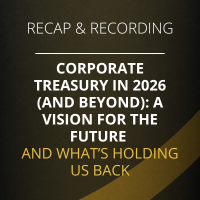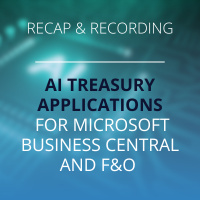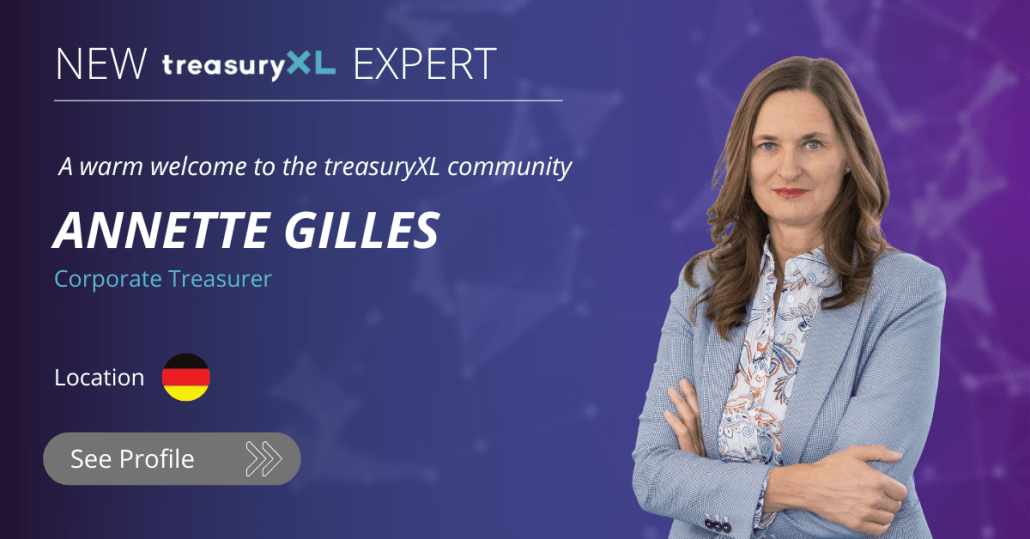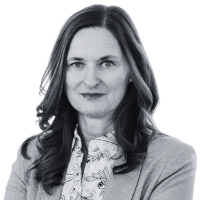Interview | Why Treasury Wins When People Come First
By treasuryXL
We are very excited to introduce our newest treasuryXL expert for our community: Annette Gilles
INTERVIEW
You are an experienced interim manager; what do you enjoy most about interim work compared to a permanent role?
I basically do different things. I do classical interim management; I take over operational tasks when there is a vacancy. I have worked in operations for about 20 years, so I know what to do in all areas of treasury: cash management, risk management, liquidity management, guarantees and managing large financing contracts.
Second, I really love implementing processes, sometimes single processes, sometimes whole treasury departments. I have set up treasury departments five times now. I was part of three carve-outs where we started from scratch, because you can’t simply take over the solutions a mid-sized company has. You need to think about how to set up treasury for a midsize company. I set up a treasury in an MDOX company and recently for a PE-owned software company.
I also do treasury assessments: analysing all treasury processes, benchmarking them and coming up with suggestions to improve, and, if desired, implementing those improvements. I enjoy seeing processes become easier, more efficient, more professional and more secure. I love working with people: convincing, aligning and supporting them during change.
I also select and implement Treasury Management Systems. I have worked with major vendors (ION, FIS Integrity, Coupa, Kyriba, etc.) and I know a wide range of TMS solutions.
Building treasury departments from scratch, you have done that more than once. In your view, what often goes wrong when companies set up a treasury for the first time?
I think it’s very important to first get the current situation: look into what is already there. From my experience, there is always something that’s very good; take that into account. Don’t go in saying, ‘I know everything better.’ Go in, look, talk to people, and then set up a plan for how to proceed.
For example, when you implement a TMS, you must not just pick a tool and digitally replicate the manual process one-to-one. If you simply copy the manual process into the TMS, it’s only digital, it doesn’t make the process better. Sometimes the process is fine and just needs digitalization, but more often you should change parts of the process to make it more effective and efficient. Start with understanding the process, then decide what to digitize or improve.
You have been involved in a wide range of projects, from liquidity planning to ESG and M&A. Can you name a project that really stuck with you, and why?
The one project that really stood out was the recent software company where we set up the treasury and brought together people with very different knowledge. That was challenging because the knowledge base varied widely. People joining a new group is hard already; they had to learn and change not only treasury processes but many other finance processes, and there were changes across HR, marketing and R&D too. People were overwhelmed.
That combination of changes made this the most challenging project I have had, and in the end, the most rewarding, because it worked. It’s amazing how people adapted to the new processes and bore the pressure and expectations. It’s fine to have everything implemented, banks connected, payments working, credits and FX in the tool, but if nobody uses it, it won’t work.
“I always say: you don’t do digitalization for digitalization’s sake; you do it for people. If you don’t include them, it won’t work”
Some CFOs still see treasury as a back-office topic. How do you usually help them spot the value of getting it right early on?
Many CFOs are aware they have a need; they want a quick glance at cash and to know where liquidity is developing. They want quick and, importantly, good and profound answers based on real, reliable data. But many CFOs come from controlling or accounting, not from treasury, so they might not always know what treasury can do. Some rely solely on top-down liquidity planning, but turnover isn’t cash.
Bottom-up liquidity planning takes into account customers who pay late or projects that are delayed; these factors delay cash-in. You should have both top-down and bottom-up planning. Efficient treasury processes can save a lot of money: in the software company, we implemented cash pooling across many small entities. With the first ~30 entities included, they were able to repay a €20m RCF and saved €1.5m in external interest; the project paid for itself.
Also, there are many regulations to follow. As a member of management, a CFO can be personally liable if regulations aren’t followed. That personal exposure makes it in their interest to set up treasury properly.
Looking ahead: are there any treasury themes or trends that you think everyone should keep an eye on in 2025?
Cash is still king! I don’t think that will change. Especially now, with companies struggling in several markets, it’s time to take a close look at cash, liquidity and good treasury processes, even if you’re currently cash-rich. Look at cash and liquidity when times are good so you don’t have problems later.
A good liquidity plan takes time to mature and produce dependable data; once it does, it gives you red flags and early warnings. Make sure you gather information about single people in the organisation, information you can’t see in the books. Be proactive: always maintain that oversight. In restructurings, I have seen either a poor cash view or missing bottom-up liquidity planning (often both). While I can’t say this always prevents insolvency, it often would have provided an early warning so actions could have been taken. Treasury can’t create sales, but you must understand what will happen to your bank accounts, at least for the next 12 months.
What can the treasuryXL community come to you for, whether it’s input, support, or simply a good treasury conversation?
Whenever somebody has a question or needs support, I am here. I’m currently available; that might change quickly, you never know. But even if there’s no project afterwards, I’m open to talking and helping. Topics I cover: cash and liquidity, financing, administration, risk management, and TMS implementation. And soon, you might also expect me in an upcoming treasuryXL webinar, so join me there for an interactive exchange!
Meet Annette Gilles
Annette is an experienced interim manager and strategic treasury consultant with 20+ years across industries, specializing in cash and liquidity management, FX, financing, and building future-proof treasury structures.
She combines strategic insight with hands-on implementation, guiding companies through complex transformations such as restructurings, carve-outs, and M&A, while ensuring sustainable and compliant treasury operations.
Can’t get enough? Check out these latest items
 https://treasuryxl.com/wp-content/uploads/2025/12/Copy-of-Live-Session-Nomentia-1.png
200
200
treasuryXL
https://treasuryxl.com/wp-content/uploads/2018/07/treasuryXL-logo-300x56.png
treasuryXL2025-12-19 08:49:372025-12-19 09:41:43Recap & Recording: Corporate Treasury in 2026 and beyond
https://treasuryxl.com/wp-content/uploads/2025/12/Copy-of-Live-Session-Nomentia-1.png
200
200
treasuryXL
https://treasuryxl.com/wp-content/uploads/2018/07/treasuryXL-logo-300x56.png
treasuryXL2025-12-19 08:49:372025-12-19 09:41:43Recap & Recording: Corporate Treasury in 2026 and beyond https://treasuryxl.com/wp-content/uploads/2025/11/Aastha-blog.png
200
200
treasuryXL
https://treasuryxl.com/wp-content/uploads/2018/07/treasuryXL-logo-300x56.png
treasuryXL2025-11-27 07:00:432025-11-26 09:39:58Africa’s Critical Minerals Boom and What It Means for Treasury
https://treasuryxl.com/wp-content/uploads/2025/11/Aastha-blog.png
200
200
treasuryXL
https://treasuryxl.com/wp-content/uploads/2018/07/treasuryXL-logo-300x56.png
treasuryXL2025-11-27 07:00:432025-11-26 09:39:58Africa’s Critical Minerals Boom and What It Means for Treasury https://treasuryxl.com/wp-content/uploads/2025/05/Francois-Template_BLOGS-Expert-featured-7.png
200
200
treasuryXL
https://treasuryxl.com/wp-content/uploads/2018/07/treasuryXL-logo-300x56.png
treasuryXL2025-11-24 08:30:272025-11-24 08:32:52Roundtable on Alternative Methods of Funding
https://treasuryxl.com/wp-content/uploads/2025/05/Francois-Template_BLOGS-Expert-featured-7.png
200
200
treasuryXL
https://treasuryxl.com/wp-content/uploads/2018/07/treasuryXL-logo-300x56.png
treasuryXL2025-11-24 08:30:272025-11-24 08:32:52Roundtable on Alternative Methods of Funding https://treasuryxl.com/wp-content/uploads/2025/11/Live-Session-Embat-2.png
200
200
treasuryXL
https://treasuryxl.com/wp-content/uploads/2018/07/treasuryXL-logo-300x56.png
treasuryXL2025-11-19 10:59:252025-11-19 10:59:25Recap & Recording: AI Treasury Applications for Microsoft Business Central and F&O
https://treasuryxl.com/wp-content/uploads/2025/11/Live-Session-Embat-2.png
200
200
treasuryXL
https://treasuryxl.com/wp-content/uploads/2018/07/treasuryXL-logo-300x56.png
treasuryXL2025-11-19 10:59:252025-11-19 10:59:25Recap & Recording: AI Treasury Applications for Microsoft Business Central and F&O https://treasuryxl.com/wp-content/uploads/2025/11/Copy-of-Live-Session-Nomentia.png
200
200
treasuryXL
https://treasuryxl.com/wp-content/uploads/2018/07/treasuryXL-logo-300x56.png
treasuryXL2025-11-14 14:11:432025-11-20 14:44:49Live Session: Corporate Treasury in 2026 (and beyond): A Vision for the Future – and What’s Holding Us Back
https://treasuryxl.com/wp-content/uploads/2025/11/Copy-of-Live-Session-Nomentia.png
200
200
treasuryXL
https://treasuryxl.com/wp-content/uploads/2018/07/treasuryXL-logo-300x56.png
treasuryXL2025-11-14 14:11:432025-11-20 14:44:49Live Session: Corporate Treasury in 2026 (and beyond): A Vision for the Future – and What’s Holding Us Back https://treasuryxl.com/wp-content/uploads/2025/11/Live-Session-Embat-1.png
200
200
treasuryXL
https://treasuryxl.com/wp-content/uploads/2018/07/treasuryXL-logo-300x56.png
treasuryXL2025-11-10 10:55:432025-11-19 13:11:33Live Session: AI Treasury Applications for Microsoft Business Central and F&O
https://treasuryxl.com/wp-content/uploads/2025/11/Live-Session-Embat-1.png
200
200
treasuryXL
https://treasuryxl.com/wp-content/uploads/2018/07/treasuryXL-logo-300x56.png
treasuryXL2025-11-10 10:55:432025-11-19 13:11:33Live Session: AI Treasury Applications for Microsoft Business Central and F&O https://treasuryxl.com/wp-content/uploads/2025/11/Aastha-blog.png
200
200
treasuryXL
https://treasuryxl.com/wp-content/uploads/2018/07/treasuryXL-logo-300x56.png
treasuryXL2025-11-10 07:00:572025-11-07 16:53:27Africa’s AI Opportunity: A New Era for Treasury and Innovation
https://treasuryxl.com/wp-content/uploads/2025/11/Aastha-blog.png
200
200
treasuryXL
https://treasuryxl.com/wp-content/uploads/2018/07/treasuryXL-logo-300x56.png
treasuryXL2025-11-10 07:00:572025-11-07 16:53:27Africa’s AI Opportunity: A New Era for Treasury and Innovation https://treasuryxl.com/wp-content/uploads/2025/11/Live-Session-TS-1.png
200
200
treasuryXL
https://treasuryxl.com/wp-content/uploads/2018/07/treasuryXL-logo-300x56.png
treasuryXL2025-11-07 09:00:202025-11-06 14:24:47Recap & Recording: Treasury Education: Skills for Today and Tomorrow
https://treasuryxl.com/wp-content/uploads/2025/11/Live-Session-TS-1.png
200
200
treasuryXL
https://treasuryxl.com/wp-content/uploads/2018/07/treasuryXL-logo-300x56.png
treasuryXL2025-11-07 09:00:202025-11-06 14:24:47Recap & Recording: Treasury Education: Skills for Today and Tomorrow https://treasuryxl.com/wp-content/uploads/2024/07/Pieter-Template_BLOGS-Expert-featured.png
200
200
treasuryXL
https://treasuryxl.com/wp-content/uploads/2018/07/treasuryXL-logo-300x56.png
treasuryXL2025-10-23 07:00:172025-11-12 15:38:54From AI to Macro Trends: What Treasurers Took Away from EuroFinance Budapest
https://treasuryxl.com/wp-content/uploads/2024/07/Pieter-Template_BLOGS-Expert-featured.png
200
200
treasuryXL
https://treasuryxl.com/wp-content/uploads/2018/07/treasuryXL-logo-300x56.png
treasuryXL2025-10-23 07:00:172025-11-12 15:38:54From AI to Macro Trends: What Treasurers Took Away from EuroFinance Budapest



